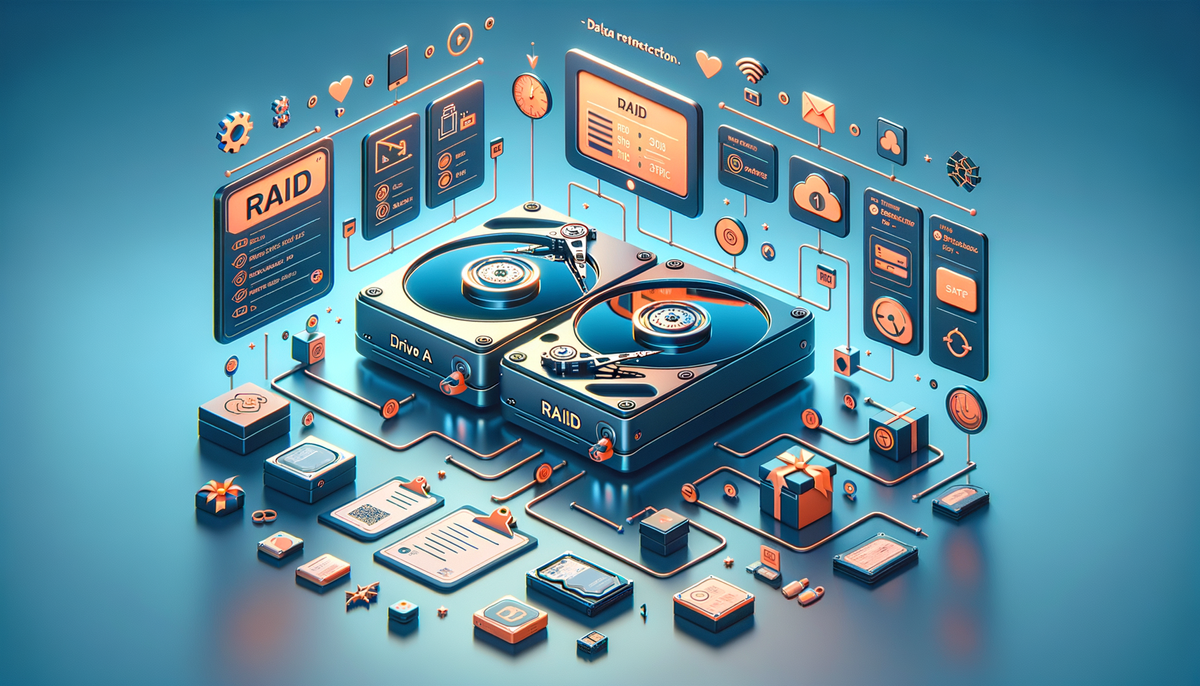RAID 1: A Detailed Explanation for Beginners
RAID 1 (mirroring) is a simple and effective way to protect your data from hard drive failure. Imagine having a backup of your important files, automatically created in real-time. This guide explains RAID 1, its benefits, and how to set it up in Windows and Linux.

Introduction
RAID 1, or "mirroring," is a simple and effective way to protect your important data from hard drive failure. Imagine you have a photo album with precious memories, but you're worried it might get damaged. RAID 1 is like making a copy of that album and storing it in a separate, safe place. If one copy gets lost or damaged, you still have the other one. This guide will break down how RAID 1 works, its benefits, and how you can set it up.
Understanding RAID 1
What is RAID 1?
RAID stands for "Redundant Array of Independent Disks." RAID 1 is like having two identical twins working together. When you save a file, it gets copied to both drives. So, if one drive stops working, the other one still has the entire file, saving you from losing anything.
How RAID 1 Works
Imagine you have two hard drives: Drive A and Drive B. Whenever you save a picture, a document, or any file, RAID 1 automatically copies that file to BOTH drives at the same time. This way, if Drive A breaks, you can still access everything from Drive B. It's like having a backup copy of everything, all the time!
Why Use RAID 1?
Keeping Your Data Safe
- Data Protection: If one drive fails, you won't lose your precious data. It's like having a backup, but it happens automatically!
- Peace of Mind: You can relax knowing that your important photos, videos, and documents are safe. No more worrying about losing everything if your hard drive goes kaput!
Practical Uses
- Families: RAID 1 is perfect for safeguarding those irreplaceable photos and videos of your kids growing up.
- Small Businesses: RAID 1 ensures you won't lose customer records or important financial documents if a drive fails.
Setting Up RAID 1
Getting Ready
To set up RAID 1, you need:
- Two or More Hard Drives: Make sure they are the same size. It's like having two identical photo albums for the same pictures.
- RAID Controller: This is like the person organizing your photo albums. It can be built into your computer's motherboard or you can get a separate one.
- RAID Software (Sometimes): Some computers have built-in RAID options. If not, you'll need to use a program to help you set it up.
Step-by-Step Guide
- Install Hard Drives: Open your computer and put the drives in their slots. Connect them using cables to power them up.
- Enter BIOS: This is like your computer's secret control room. You usually press a key like Delete, F2, or F10 when your computer starts.
- Enable RAID: Look for the storage settings and turn on RAID.
- Configure RAID: Save your changes and restart. Your computer will now let you choose how to set up RAID.
- Set Up RAID 1: Tell the computer which drives you want to use for RAID 1 and follow the instructions on the screen.
Setting Up RAID 1 in Windows Using Software
- Open Disk Management: Press the Windows key + X and select "Disk Management".
- Initialize Disks: If your new drives are not ready, right-click them and choose "Initialize Disk".
- Create a Mirrored Volume:
- Right-click one of your new drives.
- Select "New Mirrored Volume".
- Follow the wizard's instructions to choose the other drive and create your RAID 1 array.
Checking RAID Status in Linux
# Open a terminal and check RAID status
cat /proc/mdstat
# Example output:
# Personalities : [raid1]
# md0 : active raid1 sdb1[1] sda1[0]
# 102336 blocks super 1.2 [2/2] [UU]
Advantages and Disadvantages of RAID 1
What's Good About RAID 1
- Simple: Easy to set up and understand. It's like copying a photo album, no complicated steps!
- Data Safety: It's your data's superhero, protecting it from hard drive failures.
What Could Be Better
- Storage Space: You can only use half of the total space on your drives. It's like having two photo albums, but only using one at a time.
- No Speed Boost: RAID 1 only makes reading data faster, not writing data. It's like having two photo albums, but it doesn't make you browse them faster.
Frequently Asked Questions
Can I Recover Data From a Failed Drive?
Yes! If one drive breaks, you can still get all your data from the other drive. It's like having two photo albums, and one gets damaged, but the other is still perfectly fine.
Is RAID 1 a Backup Solution?
Not exactly. RAID 1 protects against hardware failures, but not things like accidentally deleting files. It's like having two photo albums, but if you accidentally tear out a page, it's gone in both.
Do All RAID Controllers Work With RAID 1?
Most modern RAID controllers and motherboards can use RAID 1. Check your computer's manual to be sure.
How Does RAID 1 Affect Speed?
RAID 1 can make reading data faster, but not writing data. It's like having two photo albums, so you can find a picture faster, but it doesn't make you put pictures in the album any faster.
Conclusion
RAID 1 is a great choice for anyone who values their data and wants a simple way to protect it from hard drive failures. By mirroring your data across two drives, RAID 1 ensures you won't lose your precious photos, documents, or videos if one drive goes out. Whether you're a home user or run a small business, RAID 1 gives you the peace of mind knowing your data is safe. So go ahead, get those hard drives set up, and sleep soundly knowing your data is protected!




